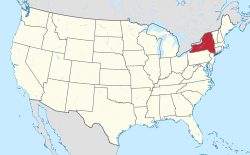Dunnsville, New York
| Guilderland | |
|---|---|
| Town | |
| Town of Guilderland | |

Guilderland Town Hall
|
|
| Etymology: Gelderland province in the Netherlands | |
| Motto: Prospice Gelria - Latin for Look Forward Guilderland | |
 Location in Albany County and the state of New York. |
|
 Location of New York in the United States |
|
| Coordinates: 42°42′5″N 73°55′31″W / 42.70139°N 73.92528°WCoordinates: 42°42′5″N 73°55′31″W / 42.70139°N 73.92528°W | |
| Country | United States |
| State | New York |
| County | Albany |
| Settled | c. 1700 |
| Incorporation as town | 1803 |
| Government | |
| • Mayor |
Peter G. Barber (D) |
| Area | |
| • Total | 58.79 sq mi (152.26 km2) |
| • Land | 57.90 sq mi (149.97 km2) |
| • Water | 0.88 sq mi (2.29 km2) |
| Elevation | 328 ft (100 m) |
| Population (2010) | |
| • Total | 35,303 |
| • Estimate (2016) | 35,745 |
| • Density | 617.31/sq mi (238.35/km2) |
| Time zone | EST (UTC-5) |
| • Summer (DST) | EDT (UTC-4) |
| ZIP Code | 12084, 12303, 12009, 12203 |
| Area code(s) | 518 |
| FIPS code | 36-001-31104 |
| FIPS code | 36-31104 |
| GNIS feature ID | 0979030 |
| Guilderland, New York | |
Peter G. Barber (D)
Guilderland is a town in Albany County, New York, United States. In the 2010 census, the town had a population of 35,303. The town is named for the Gelderland province in the Netherlands. The town of Guilderland is on the central-northwest border of the county. It is west of Albany, the capital of New York.
Guilderland was originally a part of the Manor of Rensselaerswyck begun by Patroon Kiliaen van Rensselaer in 1629 as part of the New Netherland colony. By the end of the 17th century Dutch settlers from Albany and Schenectady began to establish farms in the area, beginning first along the banks of the Normans Kill. In 1712 a group of emigrants from the Rhine Valley in present-day Germany passed through the town on their way to Schoharie. They were the first to record and name the Helderberg Escarpment, originally Hellebergh meaning "bright or clear mountain". This name would also be used for all the land between the Normans Kill and the escarpment. In 1734 the first known religious service was held by a Lutheran dominie from Athens, New York to the "Normanskill Folk", and the first religious structure was a Dutch Reformed Church in 1750.
...
Wikipedia
